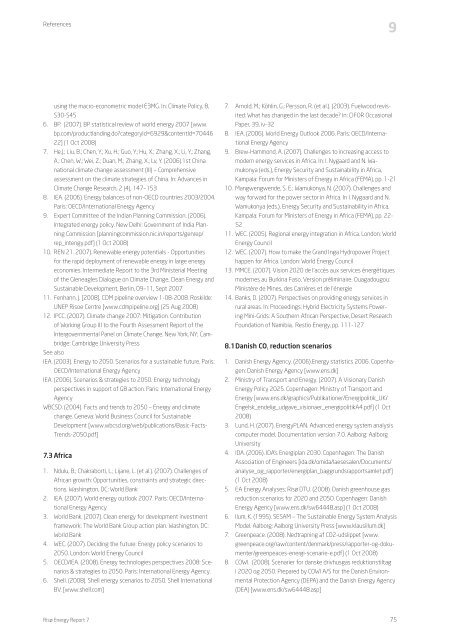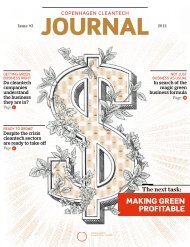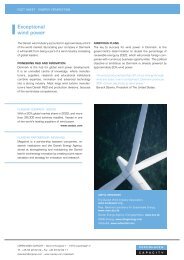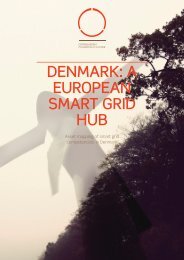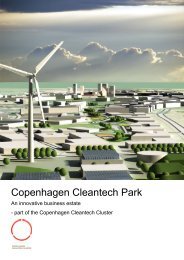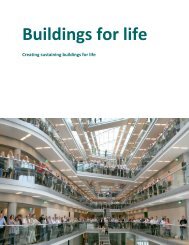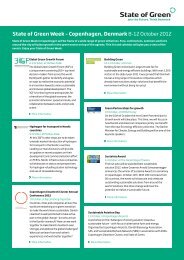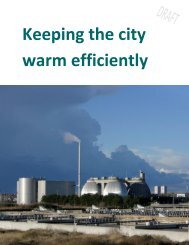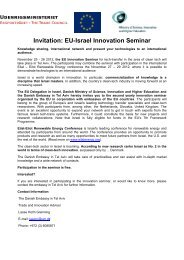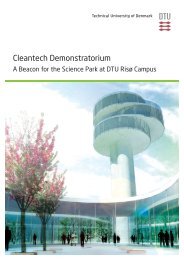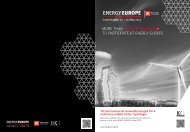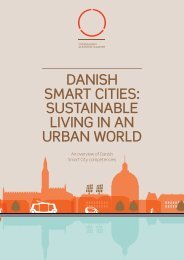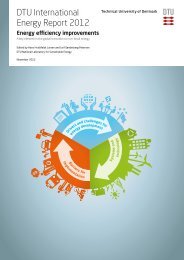Future low carbon energy systems - Copenhagen Cleantech Cluster
Future low carbon energy systems - Copenhagen Cleantech Cluster
Future low carbon energy systems - Copenhagen Cleantech Cluster
You also want an ePaper? Increase the reach of your titles
YUMPU automatically turns print PDFs into web optimized ePapers that Google loves.
References9using the macro-econometric model E3MG. In: Climate Policy, 8,S30-S456. BP. (2007). BP statistical review of world <strong>energy</strong> 2007 [www.bp.com/productlanding.do?categoryId=6929&contentId=7044622] (1 Oct 2008)7. He.J.; Liu, B.; Chen, Y.; Xu, H.; Guo, Y.; Hu, X.; Zhang, X.; Li, Y.; Zhang,A.; Chen, W.; Wei, Z.; Duan, M.; Zhang, X.; Lv, Y. (2006).1st Chinanational climate change assessment (III) – Comprehensiveassessment on the climate strategies of China. In: Advances inClimate Change Research, 2 (4), 147–1538. IEA. (2006). Energy balances of non-OECD countries 2003/2004.Paris: OECD/International Energy Agency9. Expert Committee of the Indian Planning Commission. (2006).Integrated <strong>energy</strong> policy. New Delhi: Government of India PlanningCommission [planningcommission.nic.in/reports/genrep/rep_intengy.pdf] (1 Oct 2008)10. REN 21. 2007). Renewable <strong>energy</strong> potentials - Opportunitiesfor the rapid deployment of renewable <strong>energy</strong> in large <strong>energy</strong>economies. Intermediate Report to the 3rd Ministerial Meetingof the Gleneagles Dialogue on Climate Change, Clean Energy andSustainable Development, Berlin, 09–11, Sept 200711. Fenhann, J. [2008]. CDM pipeline overview 1-08-2008. Roskilde:UNEP Risoe Centre [www.cdmpipeline.org] (25 Aug 2008)12. IPCC. (2007). Climate change 2007: Mitigation. Contributionof Working Group III to the Fourth Assessment Report of theIntergovernmental Panel on Climate Change. New York, NY; Cambridge:Cambridge University PressSee alsoIEA. (2003). Energy to 2050. Scenarios for a sustainable future. Paris:OECD/International Energy AgencyIEA. (2006). Scenarios & strategies to 2050. Energy technologyperspectives in support of G8 action. Paris: International EnergyAgencyWBCSD. (2004). Facts and trends to 2050 – Energy and climatechange. Geneva: World Business Council for SustainableDevelopment [www.wbcsd.org/web/publications/Basic-Facts-Trends-2050.pdf]7.3 Africa1. Ndulu, B.; Chakraborti, L.; Lijane, L. (et al.). (2007). Challenges ofAfrican growth: Opportunities, constraints and strategic directions.Washington, DC: World Bank2. IEA. (2007). World <strong>energy</strong> outlook 2007. Paris: OECD/InternationalEnergy Agency3. World Bank. (2007). Clean <strong>energy</strong> for development investmentframework: The World Bank Group action plan. Washington, DC:World Bank4. WEC. (2007). Deciding the future: Energy policy scenarios to2050. London: World Energy Council5. OECD/IEA. (2008). Energy technologies perspectives 2008: Scenarios& strategies to 2050. Paris: International Energy Agency.6. Shell. (2008). Shell <strong>energy</strong> scenarios to 2050. Shell InternationalBV. [www.shell.com]7. Arnold, M.; Köhlin, G.; Persson, R. (et al.). (2003). Fuelwood revisited:What has changed in the last decade? In: CIFOR OccasionalPaper, 39, iv-328. IEA. (2006). World Energy Outlook 2006. Paris: OECD/InternationalEnergy Agency9. Brew-Hammond, A. (2007). Challenges to increasing access tomodern <strong>energy</strong> services in Africa. In: I. Nygaard and N. Wamukonya(eds.), Energy Security and Sustainability in Africa,Kampala: Forum for Ministers of Energy in Africa (FEMA), pp. 1-2110. Mangwengwende, S. E.; Wamukonya, N. (2007). Challenges andway forward for the power sector in Africa. In I. Nygaard and N.Wamukonya (eds.), Energy Security and Sustainability in Africa,Kampala: Forum for Ministers of Energy in Africa (FEMA), pp. 22-5211. WEC. (2005). Regional <strong>energy</strong> integration in Africa. London: WorldEnergy Council12. WEC. (2007). How to make the Grand Inga Hydropower Projecthappen for Africa. London: World Energy Council13. MMCE. (2007). Vision 2020 de l'accès aux services énergétiquesmodernes au Burkina Faso, Version préliminaire. Ouagadougou:Ministère de Mines, des Carrières et de l'énergie14. Banks, D. (2007). Perspectives on providing <strong>energy</strong> services inrural areas. In: Proceedings: Hybrid Electricity Systems PoweringMini-Grids: A Southern African Perspective, Desert ResearchFoundation of Namibia, Restio Energy, pp. 111-1278.1 Danish CO ²reduction scenarios1. Danish Energy Agency. (2006).Energy statistics 2006. <strong>Copenhagen</strong>:Danish Energy Agency [www.ens.dk]2. Ministry of Transport and Energy. (2007). A Visionary DanishEnergy Policy 2025. <strong>Copenhagen</strong>: Ministry of Transport andEnergy [www.ens.dk/graphics/Publikationer/Energipolitik_UK/Engelsk_endelig_udgave_visionaer_energipolitikA4.pdf] (1 Oct2008)3. Lund, H. (2007). EnergyPLAN. Advanced <strong>energy</strong> system analysiscomputer model, Documentation version 7.0. Aalborg: AalborgUniversity4. IDA. (2006). IDA’s Energiplan 2030. <strong>Copenhagen</strong>: The DanishAssociation of Engineers [ida.dk/omida/laesesalen/Documents/analyse_og_rapporter/energiplan_baggrundsrapportsamlet.pdf](1 Oct 2008)5. EA Energy Analyses; Risø DTU. (2008). Danish greenhouse gasreduction scenarios for 2020 and 2050. <strong>Copenhagen</strong>: DanishEnergy Agency [www.ens.dk/sw64448.asp] (1 Oct 2008)6. llum, K. (1995). SESAM – The Sustainable Energy System AnalysisModel. Aalborg: Aalborg University Press [www.klausillum.dk]7. Greenpeace. (2008). Nedtrapning af CO2-udslippet [www.greenpeace.org/raw/content/denmark/press/rapporter-og-dokumenter/greenpeaces-energi-scenarie-e.pdf](1 Oct 2008)8. COWI. (2008). Scenarier for danske drivhusgas reduktionstiltagi 2020 og 2050. Prepared by COWI A/S for the Danish EnvironmentalProtection Agency (DEPA) and the Danish Energy Agency(DEA) [www.ens.dk/sw64448.asp]Risø Energy Report 775


